中职英语基础模块教案
中职英语基础模块1教案
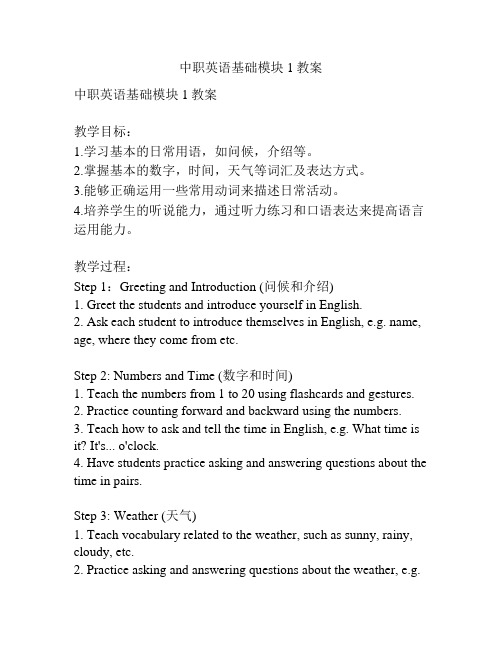
中职英语基础模块1教案中职英语基础模块1教案教学目标:1.学习基本的日常用语,如问候,介绍等。
2.掌握基本的数字,时间,天气等词汇及表达方式。
3.能够正确运用一些常用动词来描述日常活动。
4.培养学生的听说能力,通过听力练习和口语表达来提高语言运用能力。
教学过程:Step 1:Greeting and Introduction (问候和介绍)1. Greet the students and introduce yourself in English.2. Ask each student to introduce themselves in English, e.g. name, age, where they come from etc.Step 2: Numbers and Time (数字和时间)1. Teach the numbers from 1 to 20 using flashcards and gestures.2. Practice counting forward and backward using the numbers.3. Teach how to ask and tell the time in English, e.g. What time is it? It's... o'clock.4. Have students practice asking and answering questions about the time in pairs.Step 3: Weather (天气)1. Teach vocabulary related to the weather, such as sunny, rainy, cloudy, etc.2. Practice asking and answering questions about the weather, e.g.What's the weather like today? It's sunny.3. Have students work in pairs to describe the weather in different seasons.Step 4: Daily Activities (每日活动)1. Teach common daily activities using flashcards and gestures, such as eat, sleep, study, etc.2. Practice asking and answering questions about daily activities,e.g. What do you do in the morning? I eat breakfast.3. Have students work in pairs to create dialogues using the new vocabulary.Step 5: Listening and Speaking Practice (听力和口语练习)1. Play a recording of a conversation and have students listen and answer questions about the content.2. Divide the class into pairs and give them a topic to discuss, such as their favorite hobbies or weekend plans.3. Have some pairs share their discussions with the class.Step 6: Review and Assessment (复习和评估)1. Review the vocabulary and phrases learned in this lesson through a game or quiz.2. Have students individually write a short paragraph about their daily routine using the vocabulary and grammar learned.3. Collect and review the paragraphs for assessment.教学资源:- Flashcards with numbers, time, weather, and daily activities- Recording of a conversation- Game or quiz materials for review and assessment评估方法:- Observations during class activities and discussions - Participation and engagement in speaking activities - Performance in the written paragraph assessment。
中职英语基础模块教案
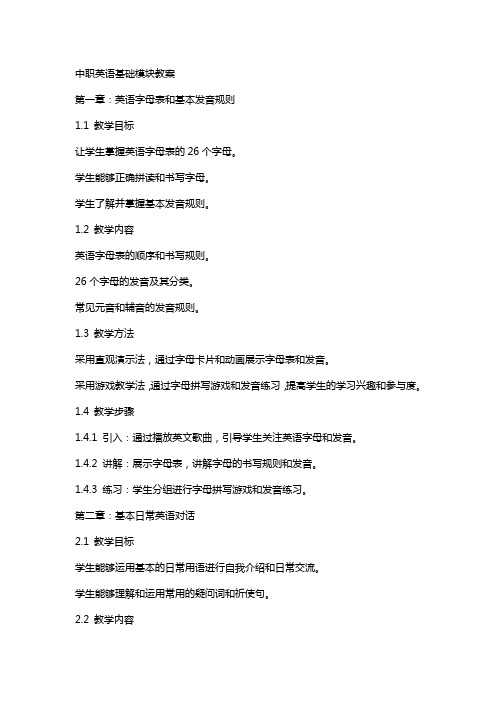
中职英语基础模块教案第一章:英语字母表和基本发音规则1.1 教学目标让学生掌握英语字母表的26个字母。
学生能够正确拼读和书写字母。
学生了解并掌握基本发音规则。
1.2 教学内容英语字母表的顺序和书写规则。
26个字母的发音及其分类。
常见元音和辅音的发音规则。
1.3 教学方法采用直观演示法,通过字母卡片和动画展示字母表和发音。
采用游戏教学法,通过字母拼写游戏和发音练习,提高学生的学习兴趣和参与度。
1.4 教学步骤1.4.1 引入:通过播放英文歌曲,引导学生关注英语字母和发音。
1.4.2 讲解:展示字母表,讲解字母的书写规则和发音。
1.4.3 练习:学生分组进行字母拼写游戏和发音练习。
第二章:基本日常英语对话2.1 教学目标学生能够运用基本的日常用语进行自我介绍和日常交流。
学生能够理解和运用常用的疑问词和祈使句。
2.2 教学内容自我介绍的常用句型和表达方式。
日常交流中的常用疑问词和祈使句。
常见的日常用语和表达方式。
2.3 教学方法采用情景教学法,通过模拟真实场景,让学生在实际情境中学习和应用日常用语。
采用交互式教学法,通过学生之间的对话和互动,提高学生的口语表达能力。
2.4 教学步骤2.4.1 引入:通过播放日常英语对话视频,引起学生的兴趣。
2.4.2 讲解:教师展示常用疑问词和祈使句,讲解其用法和意义。
2.4.3 练习:学生分组进行角色扮演,模拟真实场景进行日常对话练习。
第三章:英语数词和基本句型3.1 教学目标学生能够理解和运用1-100的英文数词。
学生能够运用基本的英语句型进行表达。
3.2 教学内容1-100的英文数词的写法和读法。
基本的英语句型及其用法。
3.3 教学方法采用直观教学法,通过数字卡片和实物展示,帮助学生理解和记忆数词。
采用任务驱动法,通过小组合作完成句子构建任务,提高学生的句型运用能力。
3.4 教学步骤3.4.1 引入:通过展示数字卡片,引导学生关注英文数词。
3.4.2 讲解:讲解1-100的英文数词的写法和读法,展示基本句型的结构。
中职英语基础模块上册(人教版)全套教案

中职英语基础模块上册(人教版)全套教案教案一:Unit 1 - Greetings and Introductions教学目标- 研究并掌握基本的打招呼和自我介绍的表达方式- 学会用英语讨论日常生活中常见的话题教学重点- 掌握英语中的基本打招呼用语,如"Hello"、"Good morning"等- 学会用英语进行自我介绍,包括姓名、年龄、家庭信息等- 研究常见的日常用语,如问候、介绍等教学内容1. 研究并模仿基本的打招呼用语,如:- "Hello"- "Good morning"- "How are you?"2. 研究并模仿基本的自我介绍用语,如:- "My name is [name]."- "I am [age] years old."- "I live in [place]."3. 进行角色扮演,练打招呼和自我介绍的对话。
4. 研究并模仿常见的日常用语,如:- "Nice to meet you."- "Where are you from?"- "What do you like to do in your free time?"教学方法- 师生互动:通过师生问答、角色扮演等方式,进行实际口语练。
- 录音练:请学生录制并回放自己的自我介绍,进行口语语音纠正。
教学评估与反馈- 老师对学生进行口语表达的纠正和评估。
- 学生之间互相评价和反馈。
教案二:Unit 2 - Daily Routines教学目标- 研究并掌握日常生活中的常见动词和词组- 能够描述自己和他人的日常活动安排教学重点- 掌握英语中常见的动词和词组,如"get up"、"have breakfast"等- 学会用英语描述自己和他人的日常活动安排教学内容1. 研究并模仿常见的日常活动动词,如:- "get up"- "have breakfast"- "go to school"2. 研究并模仿描述日常活动的句子,如:- "I get up at 7 o'clock in the morning."- "She has breakfast with her family."3. 进行角色扮演,练描述日常活动安排的对话。
中职英语基础模块2(高教版)教案:Unit4-Volunteer-Work(全6课时)精选全文
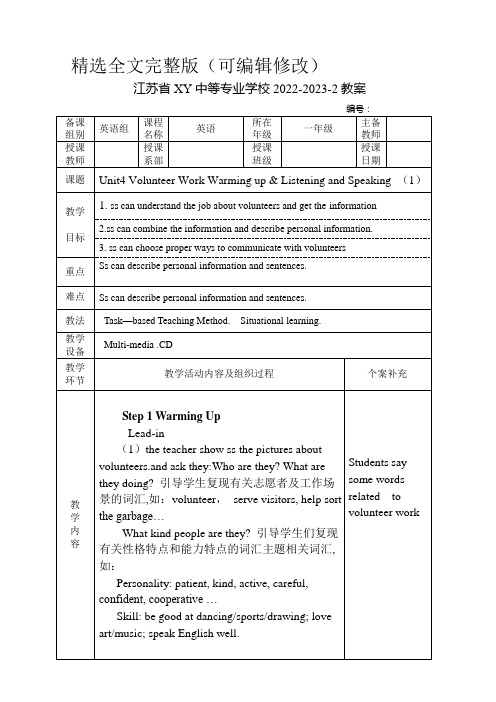
精选全文完整版(可编辑修改)
江苏省XY中等专业学校2022-2023-2教案
江苏省XY中等专业学校2022-2023-2教案
江苏省XY中等专业学校2022-2023-2教案
江苏省XY中等专业学校2022-2023-2教案
江苏省XY中等专业学校2022-2023-2教案
江苏省XY中等专业学校2022-2023-2教案
在这一学年中,不仅在业务能力上,还是在教育教学上都有了一定的提高。
金无足赤,人无完人,在教学工作中难免有缺陷,例如,课堂语言平缓,语言不够生动,理论知识不够,教学经验不足,组织教学能力还有待提高。
在今后的工作中,我将更严格要求自己,努力工作,发扬优点,改正缺点。
中职英语基础模块教案

中职英语基础模块教案【篇一:中职英语基础模块1 教学设计】中职英语基础模块1 教学设计(教案、学案)unit 6 第三课时unit 6 would you like to order?(第三课时教学设计)一、教材分析1.教学内容本课时系教材《英语1》(基础模块高教版)第六单元的第三课时,即reading and writing 部分。
本部分的主要活动是读懂菜单,在前两课时的基础上,学生已经了解了一些菜名,本部分内容要求学生通过就菜品的价格用英语进行比较,从而让学生学会在口头和书面表达中正确运用形容词比较级和最高级比较事物,进一步增加学生的学习词汇以及增强学生实际运用语言的能力。
2.教学重点、难点(1)教学重点①通过阅读菜单和表格,学生能总结并掌握形容词比较级和最高级的变化规律。
②学生能在口头及书面表达中正确运用形容词比较级和最高级比较不同餐厅③学生能根据阅读材料,纠正错误信息的表达。
(2)教学难点①学生通过文中给出的线索,猜出词义②学生能够运用阅读表格的策略对餐厅进行比较二、教学目标1. 知识目标(1)学生能理解并运用形容餐厅的词汇如,delicious, cheap, expensive等(2)学生能够正确运用形容词比较级和最高级比较各餐厅情况2. 能力目标 (1)学生能够读懂菜单,并通过文中给出的线索,猜出词义,归纳形容词比较级和最高级规律。
(2)学生能够运用形容词的比较级和最高级以书面形式简单介绍餐厅的基本情况,如路程远近,饭菜价格及质量。
3. 情感目标通过对餐厅的比较,学生外出就餐时能做出理智选择。
三、教学步骤step one lead-in (1min)teacher shows the situation: if you invite your friend to meiwei restaurant to eat out, what would youlike to order for your friend ?(设计意图:教师设定情境,让学生想象邀请朋友用餐。
中职英语基础模块1教案
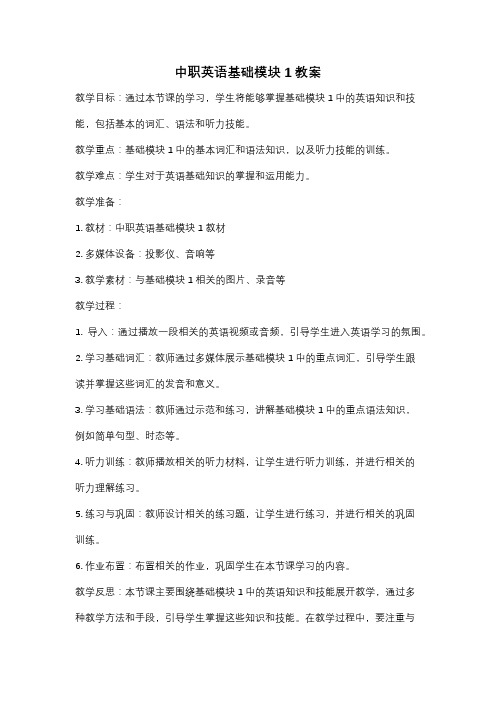
中职英语基础模块1教案
教学目标:通过本节课的学习,学生将能够掌握基础模块1中的英语知识和技能,包括基本的词汇、语法和听力技能。
教学重点:基础模块1中的基本词汇和语法知识,以及听力技能的训练。
教学难点:学生对于英语基础知识的掌握和运用能力。
教学准备:
1. 教材:中职英语基础模块1教材
2. 多媒体设备:投影仪、音响等
3. 教学素材:与基础模块1相关的图片、录音等
教学过程:
1. 导入:通过播放一段相关的英语视频或音频,引导学生进入英语学习的氛围。
2. 学习基础词汇:教师通过多媒体展示基础模块1中的重点词汇,引导学生跟
读并掌握这些词汇的发音和意义。
3. 学习基础语法:教师通过示范和练习,讲解基础模块1中的重点语法知识,
例如简单句型、时态等。
4. 听力训练:教师播放相关的听力材料,让学生进行听力训练,并进行相关的
听力理解练习。
5. 练习与巩固:教师设计相关的练习题,让学生进行练习,并进行相关的巩固
训练。
6. 作业布置:布置相关的作业,巩固学生在本节课学习的内容。
教学反思:本节课主要围绕基础模块1中的英语知识和技能展开教学,通过多
种教学方法和手段,引导学生掌握这些知识和技能。
在教学过程中,要注重与
学生的互动和引导,激发学生学习英语的兴趣,提高学生的学习积极性。
同时,要根据学生的实际情况,灵活调整教学方法和手段,确保教学效果的达成。
中职英语基础模块下unit全部教案
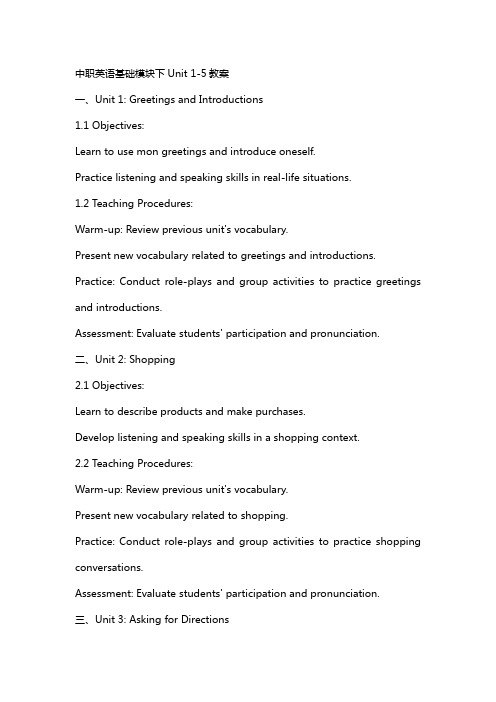
中职英语基础模块下Unit 1-5教案一、Unit 1: Greetings and Introductions1.1 Objectives:Learn to use mon greetings and introduce oneself.Practice listening and speaking skills in real-life situations.1.2 Teaching Procedures:Warm-up: Review previous unit's vocabulary.Present new vocabulary related to greetings and introductions. Practice: Conduct role-plays and group activities to practice greetings and introductions.Assessment: Evaluate students' participation and pronunciation.二、Unit 2: Shopping2.1 Objectives:Learn to describe products and make purchases.Develop listening and speaking skills in a shopping context.2.2 Teaching Procedures:Warm-up: Review previous unit's vocabulary.Present new vocabulary related to shopping.Practice: Conduct role-plays and group activities to practice shopping conversations.Assessment: Evaluate students' participation and pronunciation.三、Unit 3: Asking for Directions3.1 Objectives:Learn to ask for and give directions.Improve listening and speaking skills in a navigation context.3.2 Teaching Procedures:Warm-up: Review previous unit's vocabulary.Present new vocabulary related to asking for directions.Practice: Conduct role-plays and group activities to practice asking for directions.Assessment: Evaluate students' participation and pronunciation.四、Unit 4: Hobbies and Interests4.1 Objectives:Learn to describe hobbies and interests.Enhance listening and speaking skills in a leisure context.4.2 Teaching Procedures:Warm-up: Review previous unit's vocabulary.Present new vocabulary related to hobbies and interests.Practice: Conduct role-plays and group activities to practice describing hobbies and interests.Assessment: Evaluate students' participation and pronunciation.五、Unit 5: Family and Friends5.1 Objectives:Learn to describe family members and friends.Strengthen listening and speaking skills in a personal relationship context.5.2 Teaching Procedures:Warm-up: Review previous unit's vocabulary.Present new vocabulary related to family and friends.Practice: Conduct role-plays and group activities to practice describing family members and friends.Assessment: Evaluate students' participation and pronunciation.这只是一个初步的教案框架,您可以根据具体的教学需求和时间进行调整和补充。
中职英语基础模块教案
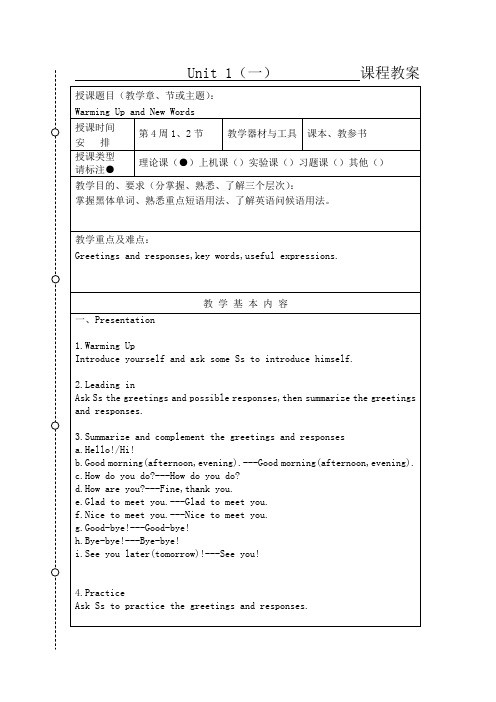
3.This is the classroom building of our school.
4.There are four reading rooms in the library.
5.Do you see the red building next to the library?
f.Nice to meet you.---Nice to meet you.
g.Good-bye!---Good-bye!
h.Bye-bye!---Bye-bye!
i.See you later(tomorrow)!---See you!
4.Practice
Ask Ss to practice the greetings and responses.
2.辅音:气流从肺部发出,在口腔或者烟头受到阻碍而形成的不一定使声带振动的音。声带不振动的音叫清辅音,声带振动的音叫浊辅音。
3.单元音[ i: ] [ e ] [ u: ] [ә] [ɔ: ] [ i ] [ a: ] [ә: ] [ u ] [Λ] [ɔ] [æ]
双元音[ eә] [ iә] [ uә] [ɔi ] [әu ] [ ai ] [ au ] [ ei ]
Unit 1(一)课程教案
授课题目(教学章、节或主题):
Warming Up and New Words
授课时间
安排
第4周1、2节
教学器材与工具
课本、教参书
授课类型
请标注●
理论课(●)上机课()实验课()习题课()其他()
教学目的、要求(分掌握、熟悉、了解三个层次):
掌握黑体单词、熟悉重点短语用法on,evening).---Good morning(afternoon,evening).
- 1、下载文档前请自行甄别文档内容的完整性,平台不提供额外的编辑、内容补充、找答案等附加服务。
- 2、"仅部分预览"的文档,不可在线预览部分如存在完整性等问题,可反馈申请退款(可完整预览的文档不适用该条件!)。
- 3、如文档侵犯您的权益,请联系客服反馈,我们会尽快为您处理(人工客服工作时间:9:00-18:30)。
Senior English For V ocational SchoolStudent’s Book Basic Module IIUnit 5Danger and SafetyTeaching Aims:● Be aware of the danger of daily life● Learn about the safety signs● Learn how to handle emergency● Learn about the phonetics: Word stress● Master the grammar: Imperative sentences● Get prepared in an emergency● Real life skills: What will you do at the emergency?● How to keep yourself safeTeaching Time:Period 1 Warming up and DiscussionPeriod 2 Listening and Speaking Part APeriod 3 Listening and Speaking Part BPeriod 4 Reading and Writing —— Text and ExercisesPeriod 5 Language in Use —— Phonetics and V ocabularyPeriod 6 Real Life Skills ——What will you do at the emergency?Period 7 Further Reading and Unit SummaryPeriod 1 Warming up and DiscussionTeaching Aims:1.Be familiar with the topic “danger and safety”.2.Recognize the safety signs.3.Discuss how to handle the emergency..Teaching Key Points:1.Master some words and phrases about danger and safety.2.Enable the students torecognize the safety signs.3.Improve the students’ ability of oral English.Teaching Difficult Points:1.Be familiar with some phrases about danger and safety.e proper words to express themselves.Teaching Methods:1. Brain storming2.Group discussion: What can you do in case of emergencies, such as robbery, fire earthquake, nose bleeding,broken arm and so on?Teaching Aids:1. Multimedia2. BlackboardTeaching Procedures:Step Ⅰ GreetingsGreet the whole class as usual.Step Ⅱ Leading-inShow some pictures about safety signs and then let the students speak out the meaning of each picture.School around!Slippery floor!Keep your file safe!Wash your hands!Step Ⅲ List the words and phrases that are related to “danger and safety ”.For example: 慢(快)车道 Slow(Quick) Lane 单行道 One Way Only, Single Lane危险弯路 Dangerous Curves 三岔路 Road Junction十字路 Cross Road 当心行人 Caution pedestrian crossing安全第一 safety first 勿踏草地! Keep off the grass!前方没有红绿灯 Traffic lights ahead 减速Slow down注意危险Watch out for danger 人行横道 Pedestrian crossing请小心驾驶Please drive carefullyStepKey points:1. lie down 躺下(休息或睡眠)Why don't you go upstairs and lie down for a bit? 你不为什么不上楼去躺一会儿呢?Liedown on the couch if you're feeling ill. 如果你感觉不舒服就躺到沙发上去。
Let's liedown for a rest. 咱们躺下休息一会儿。
A fit of dizziness came over her so she had to liedown. 她突然感到头晕,不得不躺下来。
lie一词有两个基本意思。
一是“躺下”;一是“说谎”。
只是要注意它在不同的意思里,过去式和过去分词的形式也不同。
‘躺下’分别为lie, lay, lain;‘说谎’则是lie, lied, lied。
2. deal with①与...交涉,交易;应付;处理He has learnt to deal properly with all kinds of complicated situations.他已学会恰当地应付各种复杂局面。
②关于This book deals with an important. 这本书论及一个重要的问题。
do with 常与连接代词what 连用,而deal with 常与连接副词how 连用,如:I don’t know how they deal with the problem. (= I don‘t know what they do with the problem. )我不知道他们如何处理这个问题。
He is easy to deal with. (= He is easy to do with. 这时“do”是不及物动词)他是容易相处的人.这两个词组在使用时有细微的差别。
一般地说,do with 表示“处置”、“忍受”、“相处”、“有关”等。
如:They found a way to do with the elephant. 他们找到对付那头大象的办法了。
We can’t do with such carelessness. 我们不能容忍这种粗枝大叶的作风。
We are difficult to do with the new comer. 我们很难与新来的那个人相处。
I have nothing to do with him. 我跟他无任何关系。
deal with 意义很广,常表示“对付”、“应付”、“处理”、“安排”、“论述”、“涉及”等。
如:They could properly deal with all kinds of situations.他能恰当地应付各种局面。
Deal with a man as he deals with you.以其人之道,还治其人之身。
This is a book dealing with Asian problems.这是一本论述亚洲问题的书。
They have learned to deal with various persons. 他们学会了和各种人打交道。
3. broken armbroken1(break的过去分词)broken2形容词a.①破碎的;损坏的Let's sweep away the broken glass.让我们把这些碎玻璃扫走。
Joe's watch is broken.乔的手表坏了。
②被破坏的;遭违背的After a broken promise, it is hard to count on a person.一次失约,再要人相信你就难了。
③不连续的;中断的She said she had a broken sleep last night.她说昨夜她睡得不熟,常常醒。
④衰弱的;沮丧的;低沉的John suffered from a broken spirit.约翰心灰意懒。
⑤(婚姻)破裂的;(家庭)破碎的Most of these children come from broken families.这些孩子中的多数人来自婚姻破裂的家庭。
⑥(语言)拙劣的,不流利的Alison speaks broken French.艾莉森讲法语结结巴巴。
Step Ⅴ Summary and HomeworkSummary: In this class, we have discussed an important part in our daily life—— danger and safety. We have known that how to handle the emergencies. We also learned some words and phases in this class.Homework: Everyone should retell an experience you once experienced in your life and then enjoy it with all the class in the next lesson.Step Ⅵ The Design of Writing on the blackboardStep Ⅶ Record after teachingPeriod 2 Listening and Speaking Part ATeaching Aims:1.Be familiar with the topic “Help! Help!”.2.Discuss why Lily calling for help.3.Learn and master the useful phrases and expressions.4.Making dialogue in pairs.Teaching Key Points:1.Master some words and phrases about help.2.Enable the students to ask for help and require some information.3.Improve the students’ ability of oral English.Teaching Difficult Points:1.Be familiar with some phrases about asking skills.e proper words to express themselves.3.Discuss how to provide the credible information while you are in an emergency.Teaching Methods:1.Brain storming2.Group discussion: What should you do when you are in an emergency?Teaching Aids:1. Multimedia2. BlackboardTeaching Procedures:Step Ⅰ GreetingsGreet the whole class as usual.Step Ⅱ Leading-inAsk some students to state the emergency who once experienced.So can you tell me what to do with it?Step ⅢListen to the dialogue: Part A “Help! Help!”First, listen, and then tick the answer: the reason for lily’s calling for help.Second, listen again, and thenunderline the sentences asking for help and requiring more information in the conversation.Lily: Help!My house is on fire!Operator: Please try to stay calm and tell me your name and address.Lily: My name is Lily Simmons. I live at 14 Central Road.Operator: Help is on the way. Do you know what caused the fire?Lily: Oh, it was all my fault. I left candles burning and forgot them.Operator: I see. Is everyone out of the house?Lily: Yes, but I’m very worried about my cat, Mimi. I couldn’t find her before I left.Operator: We’ll try to help you find her. Just stay out of the house and we’ll be there in a couple of minutes.Key words and phrases:1. stay clam: 保持冷静(平静)继续,保持I hope the weather will stay fine.我希望天气能持续放晴。
